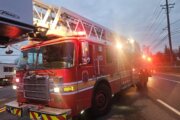WASHINGTON — The National Capital Region Transportation Planning Board unveiled a Constrained Long-Range Transportation Plan on Wednesday that added projects to put more tolls on Interstate 66 and widen the highway outside the Capital Beltway.
Lawmakers are expected to approve the list in October, but the new additions spurred debate about the projects inside and outside the Beltway.
“Virginia needs to realize that there will be an increasing scarcity of the ability to put single-occupancy vehicles into the District of Columbia,” says Falls Church Vice Mayor Dave Snyder. “It needs to particularly gear its I-66 inside-the-Beltway policy to change the mode share dramatically to support transit, bike and pedestrian. Otherwise people will simply be on a wider highway, literally a highway to nowhere.”
Arlington Board Member Jay Fisette spoke in favor of the proposal. He joins board chair Mary Hynes in giving a positive assessment of the Virginia Department of Transportation’s plans.
“I am cautiously optimistic as this unfolds that we will have a plan that works for our community to move more people and not focus only on the vehicles,” says Fisette.
Major transportation projects must be placed on the long-range transportation plan in order to receive federal funding.
As WTOP first reported, VDOT plans to charge $7 in the morning and $9 in the afternoon for commuter traffic that peaks during rush hour. Those driving against the commute would be charged $1 to $2 between 2017 and 2020.
Toll prices would change after the format for the interstate’s high-occupancy vehicle lanes shifts from a two-person-per-vehicle minimum to a three-person minimum — which the transit plan requires to occur by the year 2020.
The Fairfax County Board of Supervisors favorably reviewed the plans at a meeting last Friday. Arlington and Falls Church have not taken official positions yet on the project.
While most people support the plans on I-66 inside the Beltway, a vocal group of people are upset that VDOT will not widen the highway upfront when it adds the tolls.
“I would say a poll would show that the overwhelming percentage of people in Northern Virginia, including in Arlington, would favor widening I-66,” says Bob Chase, President of the Northern Virginia Transportation Alliance. “It’s such an obvious need. Traffic backs up on I-66 all the time. It spills over into local neighborhoods.”
The state transit department decided to delay widening I-66 inside the Beltway until the 2020s, when plans to re-evaluate traffic conditions. Many consider the move a compromise, meant to placate lawmakers in Arlington and Falls Church, and gain support for the tolling plan.
“This proposal from the Virginia Department of Transportation is based on a multimodal study that actually looked at how to move more people through the corridor,” says Fisette. “If you can do it at low cost, as is proposed, why not? Then at some point down the road, after the improvements, you’ll study it and if you don’t need widening, why do it?”
Outside the Beltway
Plans for I-66 outside the Beltway call for three general-purpose (free) lanes and two toll lanes. It would also leave room in the median to extend Metro into Centreville. The Virginia Department of Transportation released a video on Tuesday showing commuters exactly what it plans to do on I-66 outside the Beltway.
Transportation Secretary Aubrey Layne will also hold a briefing Thursday.
But in the debate about the Long-Range Transportation Plan there are concerns about the plans and what they will mean for commuters over the next several decades.
“I worry that we are, with this outside the Beltway project on I-66, creating an entire new generation of commuter expectations about the ability to move from the outer reaches to the inner parts of the metropolitan area in an automobile-dominated way,” says Peter Schwartz, Fauquier County supervisor.
Critics of the I-66 plan outside the Beltway would prefer if VDOT focused on mass transit options such as improving VRE and Metro. The state transit department is working with transit officials in Richmond to build a carpool culture, with slugging along the I-66 corridor and rapid bus service to assuage some of those concerns.
“We remain upset that they never looked at land-use solutions such as a better rural conservation in the outer areas, more transit-oriented development in the corridor, and a transit oriented solution first,” says Stewart Schwartz, executive director of the Coalition for Smarter Growth. “Neither the prior administration, nor the current administration did that. They jumped to the conclusion that they should do HOT (toll) lanes.”
Unlike inside the Beltway, which the public will finance, no decision has been made outside the Beltway. The Commonwealth Transportation Board has approved a plan to allow Layne to pursue public and private options.
Under the public option, VDOT would pay the upfront costs but would also be able to keep all the toll revenue. Under the private option, a company would incur most of the costs to build the lanes, and it would keep the tolls to pay off the debt. The Interstates 495 and 95 express lanes, operated by Transurban, are examples of the private option.
Layne is expected to decide which option to pursue in December.







